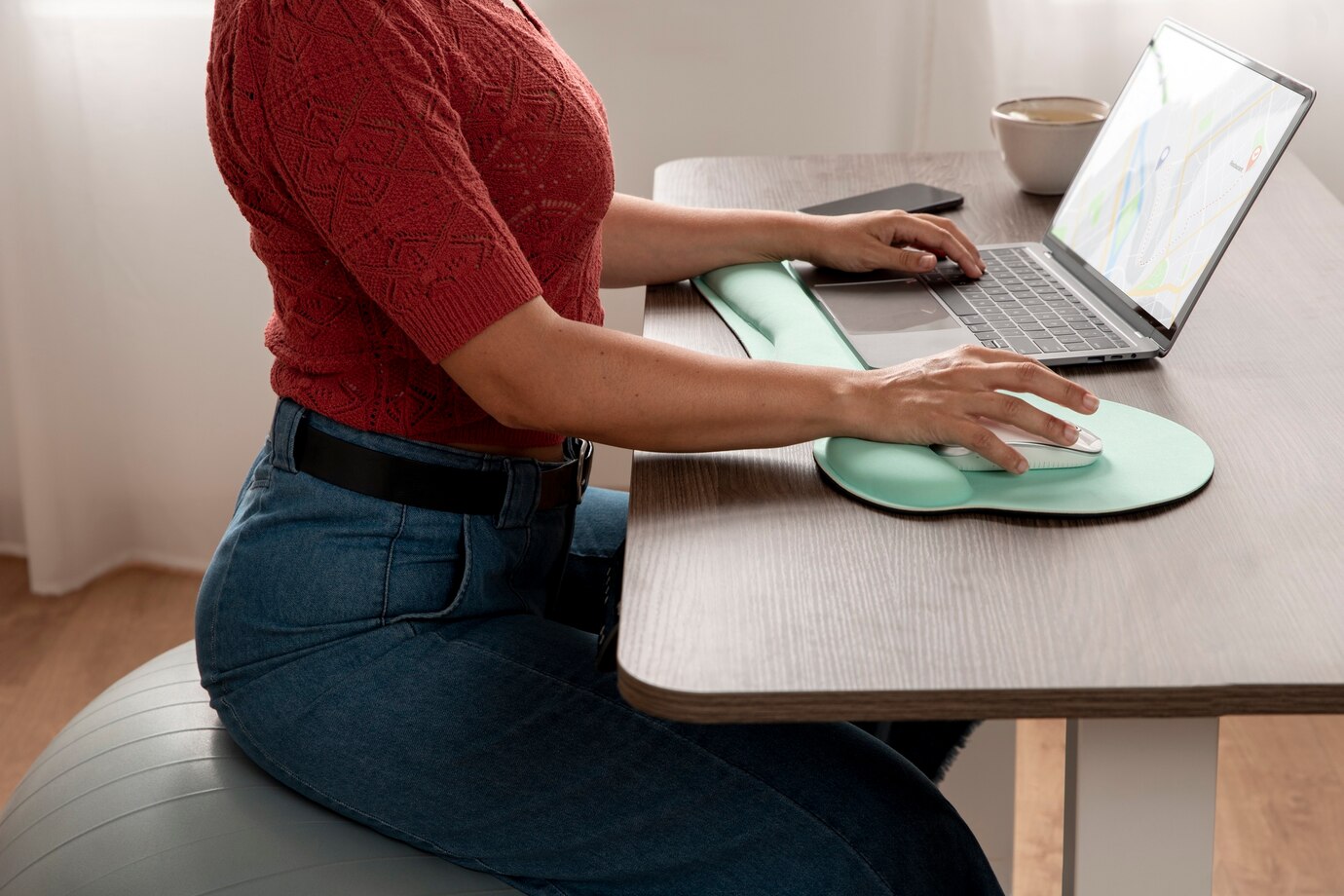
How to Stay Healthy at a Desk Job
Desk jobs usually involve long hours of sitting. You spend a lot of time looking at screens and moving very little. A sedentary lifestyle can cause health issues over time. The issues can be bad posture, gaining weight, eye strain, heart disease, and others. You can improve office wellness with a few simple changes. These habits will help you stay active and healthy during your workday.
The guide shares helpful tips for being active at work. It offers tips for staying active, working comfortably, and making small changes. All this to enhance your desk job.
The Health Risks of a Sedentary Desk Job

1. Poor Posture & Back Pain
- Sitting for long hours can lead to slouching and spinal misalignment.
- Increases strain on the neck, shoulders, and lower back.
- Weakens core muscles, leading to chronic discomfort.
- Can contribute to sciatica, a condition causing pain along the lower back and legs.
2. Weight Gain & Metabolic Issues
- A sedentary lifestyle slows down metabolism, making it easier to gain weight.
- Sitting for extended periods reduces calorie burning and leads to fat accumulation.
- Raises the risk of metabolic syndrome. This includes high blood pressure, obesity, and insulin resistance.
- Can contribute to digestive issues due to prolonged inactivity after eating.
3. Increased Risk of Chronic Diseases
- Sitting for too long can cause chronic diseases. This may include heart disease, diabetes, and high blood pressure, research shows.
- Reduces circulation, increasing the risk of blood clots and varicose veins.
- May lead to high cholesterol and elevated blood sugar levels.
- Sitting for long hours can raise the risk of certain cancers, like colon and breast cancer.
4. Eye Strain & Headaches
- Staring at a screen for hours can cause digital eye strain, leading to headaches and dry eyes.
- Blue light exposure can disrupt sleep cycles and cause insomnia.
- Prolonged screen time may cause blurred vision, discomfort, and difficulty focusing.
- Can contribute to migraines and chronic tension headaches.
5. Reduced Energy Levels & Mental Fatigue
- Lack of movement leads to poor circulation and brain fog.
- Sitting too long can cause fatigue and reduced productivity.
- Increases cortisol levels, leading to stress and anxiety.
- Can negatively impact creativity, decision-making, and focus.
Quick Guide: Staying Healthy at a Desk Job
- Set Up an Ergonomic Workstation
Align your chair, screen, and keyboard to reduce strain. - Move Often
Take standing or stretching breaks every 30–60 minutes. - Snack Smarter
Choose healthy, energising snacks and stay hydrated. - Protect Your Eyes
Follow the 20-20-20 rule to prevent screen fatigue. - Stay Active After Work
Incorporate walking, strength training, or hobbies into your routine.
Pro Tip
Use your calendar or phone alarms to schedule movement reminders. Even a two-minute stretch or walk break can help prevent fatigue and discomfort.
Important
You don’t need to overhaul your lifestyle overnight. Focus on one habit at a time—like posture, hydration, or breaks. When small actions become routine, the long-term health benefits follow naturally.
Office Wellness Tips for Staying Healthy at Work

1. Set Up an Ergonomic Workspace
- Adjust Your Chair: Keep feet flat on the ground and knees at a 90-degree angle.
- Monitor Position: Place the screen at eye level to reduce neck strain.
- Keyboard & Mouse Placement: Keep your wrists straight. This helps prevent carpal tunnel syndrome.
- Use a lumbar support cushion to maintain proper spinal alignment.
- If possible, use an ergonomic desk and adjustable chair to reduce muscle tension.
2. Take Frequent Movement Breaks
- Stand up and stretch every 30-60 minutes.
- Use reminders or apps to prompt short movement sessions.
- Walk around the office, take the stairs, or do light stretching exercises.
- Take microbreaks. Roll your shoulders or stretch your legs while at your desk.
3. Incorporate Simple Desk Exercises
- Seated leg lifts and ankle circles to promote circulation.
- Desk push-ups or chair squats for strength.
- Neck and shoulder rolls to reduce tension.
- Perform seated spinal twists to relieve back stiffness.
- Try standing calf raises to keep leg muscles engaged.
4. Stay Hydrated & Eat Mindfully
- Keep a water bottle at your desk and drink regularly.
- Avoid excessive caffeine and opt for herbal teas.
- Choose healthy snacks like nuts, fruits, and protein bars instead of processed foods.
- Plan balanced meals with lean proteins, whole grains, and vegetables. This will sustain energy levels.
- Reduce consumption of sugary drinks and energy drinks that cause crashes.
5. Optimise Your Workstation for Movement
- Use a standing desk or adjustable workstation to alternate between sitting and standing.
- Walk while taking phone calls.
- Take the stairs instead of the elevator when possible.
- Consider using a balance ball chair to engage core muscles while sitting.
- Try a desk treadmill or under-desk cycling machine for added movement.
6. Reduce Screen-Related Eye Strain
- Follow the 20-20-20 rule (every 20 minutes, look at something 20 feet away for 20 seconds).
- Adjust screen brightness and contrast to reduce glare.
- Use blue light filters or computer glasses if needed.
- Blink frequently to keep your eyes hydrated and prevent dryness.
7. Manage Stress & Mental Well-being
- Practice deep breathing or meditation during short breaks.
- Keep your workspace organised and clutter-free to reduce stress.
- Engage in short relaxation techniques, such as listening to calming music.
- Take a few minutes to practice gratitude journaling to boost positivity.
- Foster social connections by engaging with coworkers in meaningful conversations.
Staying Active Outside of Work
To fight the effects of sitting all day, add physical activity to your life after work.
1. Schedule Regular Exercise
- Aim for at least 150 minutes of moderate exercise per week.
- Include strength training 2-3 times a week to maintain muscle mass.
- Try yoga or pilates to improve flexibility and reduce stiffness.
2. Walk More Throughout the Day
- Walk or bike to work if possible.
- Take a 10-minute walk after lunch to aid digestion and refresh your mind.
- Use a pedometer or fitness tracker to set daily step goals.
- Park farther from the office to add extra steps to your commute.
3. Engage in Active Hobbies
- Take up hobbies that involve movement, such as dancing, hiking, swimming, or gardening.
- Participate in recreational sports or group fitness classes.
- Join a local fitness group to stay accountable.
4. Prioritise Restful Sleep
- Ensure you get 7-9 hours of quality sleep per night.
- Limit screen time before bed to avoid blue light exposure.
- Practice a bedtime routine with relaxing activities like reading or stretching.
5 Frequently Asked Questions (FAQs)
- How often should I take breaks from my desk?
Every 30 to 60 minutes, take a short break—stand, stretch, or walk for 1–5 minutes to improve circulation and reduce stiffness. - Can a standing desk replace exercise?
No. Standing helps reduce sitting time, but it doesn’t replace physical activity. You still need regular exercise for overall health. - What are the best desk exercises I can do without equipment?
Seated leg lifts, desk push-ups, calf raises, and shoulder rolls are great low-effort options to improve mobility and circulation. - How do I reduce back pain from sitting all day?
Use lumbar support, maintain good posture, take stretching breaks, and strengthen your core with regular exercise outside of work. - Is blue light from screens really that bad?
Yes. Overexposure can disrupt your sleep and strain your eyes. Use blue light filters and limit screen time before bed.
Health at Your Desk Job

You don’t have to sacrifice your health for a desk job. These office wellness strategies will focus on coaching ergonomic work habits. They will also stress the importance of staying active during the day. This method helps you keep a good posture. You’ll feel more energised and lower health risks in the long run.
Even small changes can greatly improve your physical and mental well-being. For example, stretch regularly, stay hydrated, improve your workstation, and schedule exercise. These habits can really help, especially if you sit at a desk all day.
Start today to reclaim your workplace health. These changes take time, but they lead to a happier and more productive work life!


